Last Updated on April 5, 2024
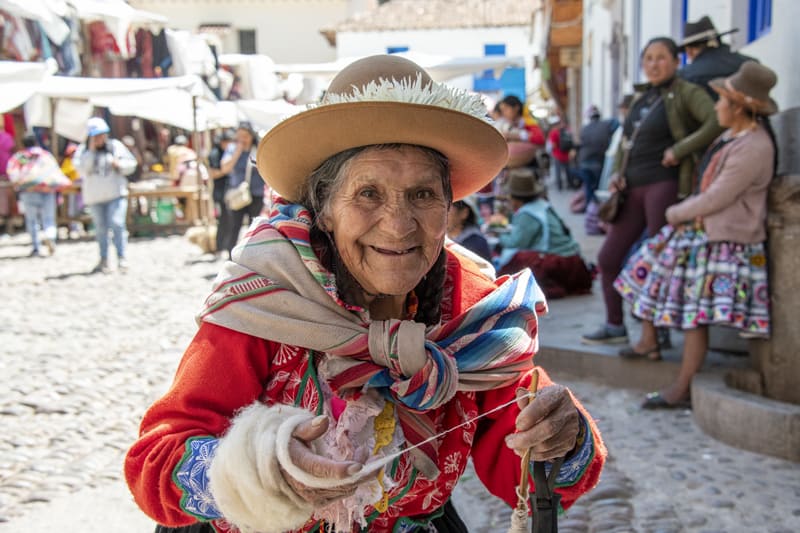
Estimated reading time: 15 minutes
Updated for 2023
By Jim Ferri
Let’s face a fact.
Despite many incredible experiences you can have in Peru, most of us are drawn there by one special place: Machu Picchu.
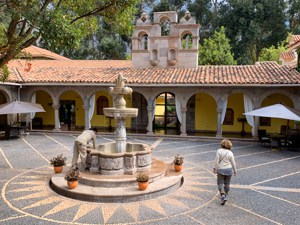
After all, who isn’t intrigued by the “lost city of the Incas?” You only need to look at all those photos of this ancient city perched precariously on a mountaintop. Talk about gorgeous surroundings…verdant forests…clouds wafting by…and thoughts about how the hell did they ever build it in the first place?
Yes, Machu Picchu cast its spell on my wife and me long before we got on the plane. But you know what? Before we got to Machu Picchu, we fell in love with the Sacred Valley in Peru.
I never knew what the Sacred Valley was. Never heard of it. But having visited it once, I’d certainly go back.
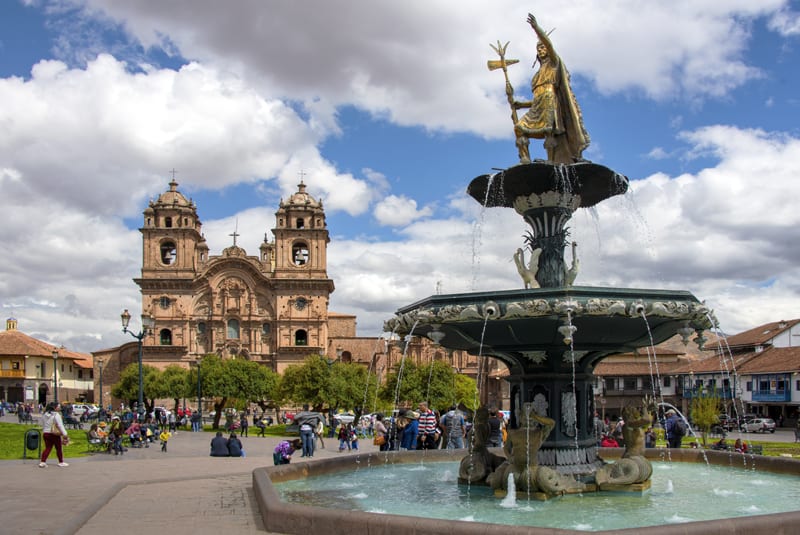
Cusco, Linked to the Sacred Valley
The city of Cusco is not actually in the Sacred Valley in Peru but it is closely tied to it.
Everything in the Sacred Valley is no further than about an hour by car from Cusco, South America’s oldest continually occupied city. But for the Incas, Cusco was more than a city. It was the epicenter and capital of their empire, the “navel of the earth.” In fact, the Inca word “Cusco” means navel.
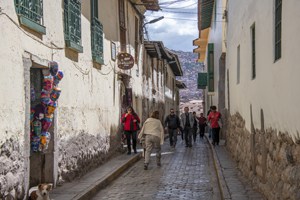
The center of the city is the Plaza de Armas, which was twice its current size in Incan times. The Spanish made it smaller and built a church and a cathedral on the foundations of two Inca temples there.
The beautiful 16th-century Cathedral took almost 100 years to build. Be sure to go inside and view its beauty. And don’t miss the painting of the Last Supper by local Peruvian painter Marcos Zapata, showing Christ and his disciples feasting on cuy (guinea pig) and drinking chicha (corn beer) from Inca cups.
indigenous Peruvians Retain Their Andean Culture
Exiting the Cathedral, we saw the statue of Inca King Pachacutec pointing to the mountains in the distance. Behind him, across the plaza, tourists enjoying lunch filled the old wooden balconies that jutted out above shops, cafes, and restaurants. All about, in the plaza and streets beyond, we saw women wearing their traditional layered skirts and stovepipe hats. Cusco, we quickly realized, is a picturesque place where the indigenous Peruvians retain their Andean culture.
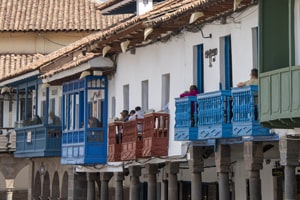
Throughout the city, buildings with the Andean Baroque architectural style of colonial Peru rise above narrow cobblestone streets. The Incas built these streets, along with the massive stone walls that line many of them.
Cusco is a great walking city, so be sure to get out of the plaza and wander its streets. Walking about will give you an understanding as to why the town is a UNESCO World Heritage Site.
If you hadn’t booked any tours before you arrived in Peru, don’t be concerned. You’ll find many travel agencies in Cusco to help you plan your adventure.
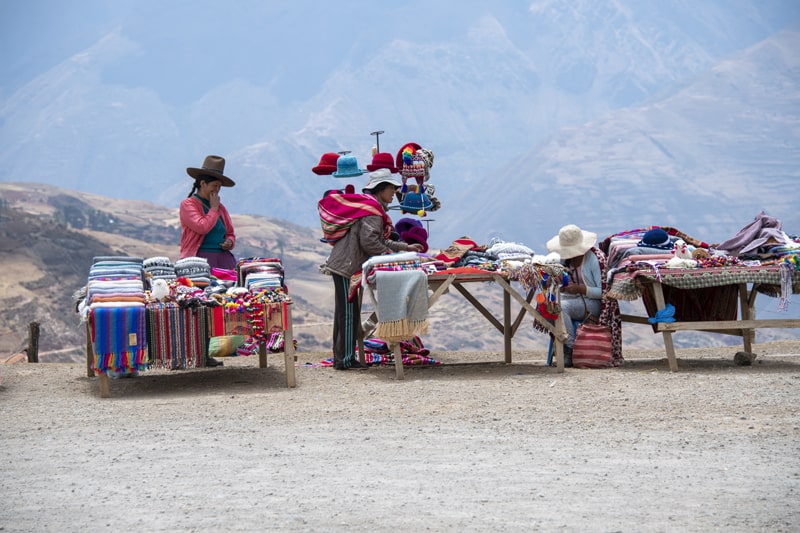
The Sacred Valley in Peru
The Sacred Valley was so named because, in the 15th century, it was a sacred place in the Inca Empire. That empire stretched almost 2,500 miles from the center of Chile to Colombia. At the time it was linked by a road network 25,000 miles long.
A 37-mile strip of land along the Urubamba River between Cusco and Machu Picchu, the Sacred Valley in Peru was the center of the Inca Empire. In the Andean highlands, its fertile land also made it the center for the Incas’ food production. And with one of the best climates in the region, Incan crops flourished there.
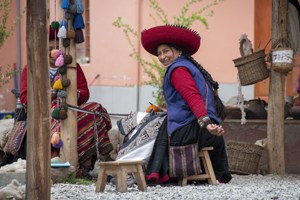
It’s a pleasant drive through the Sacred Valley on a weaving road, passing colonial towns and villages along the way. A phalanx of mountain peaks lines the valley, and ancient hillside agricultural terraces built by the Incas are everywhere.
The Sacred Valley is not only beautiful but also exceptionally interesting. And thanks to the ancient Incas, it is one of the most important historical places in South America.
It’s also the place many travelers first visit to acclimate themselves to the 7,972-foot altitude of Machu Picchu. Don’t make the mistake of going to Cusco to get acclimated since its altitude is 11,252 feet. That’s about 1,600 feet higher than the Sacred Valley.
On our way to Machu Picchu we stayed in the Sacred Valley first for a few days. After leaving Machu Picchu, we then spent some additional time in Cusco and other areas of the Valley.
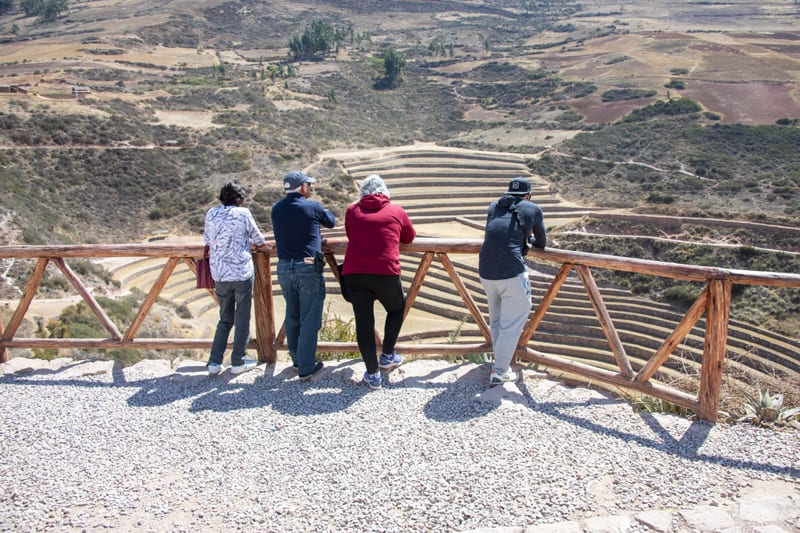
Moray, Maras and an Ancient “Red” Fortress
You’ll find many fascinating things built by the Incas in Peru’s Sacred Valley. Moray is one of them.
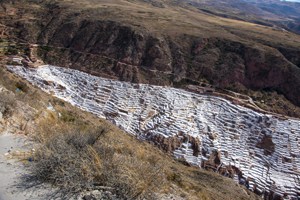
A vast series of terraces, it’s thought to initially have been a series of giant holes the Incas filled in. They used the terraces for experiments to determine which crops grew best where since each level has its own microclimate. There’s said to be a 27˚ Fahrenheit differential from the top level to the lowest.
Not far from Moray is Maras, famous for its Inca salt mines. Fed by water from a hot spring, the salt is harvested from small pools. Amazingly, they are the original Inca salt mines, which are still in use today. And like Moray, it’s another example of the Inca’s sense of ecological sensibility and responsibility.
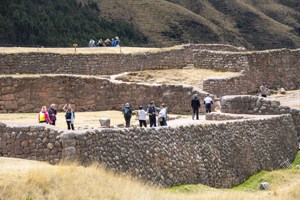
I found Puka Pukara, about 3½ miles north of Cusco, also interesting for a brief visit. Puka Pukara means “red fortress” in the Quechua language spoken by the Inca, (I was surprised to learn that Quechua is an oral, not written, language still spoken by many Peruvians, especially around Cusco).
The fort was the entry checkpoint to the capital of Cusco. It was also a resting spot for the messengers who carried communications and parcels between the Incan towns. I wondered why it was given the name “red” since it’s not red at all until I learned it takes on a red hue at sunset.
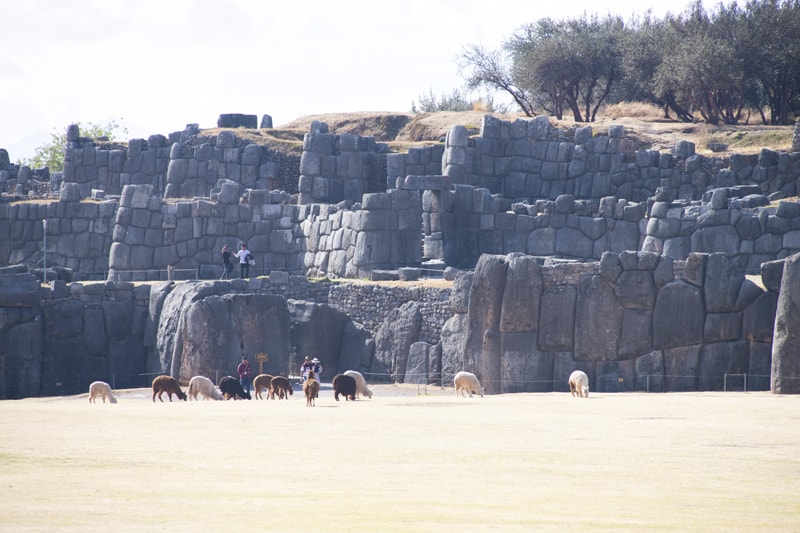
A Visit to An Architectural Masterpiece and a Holy Place
Just a 15-minute drive from the center of Cusco, Sacsayhuaman is an incredible example of Inca military engineering and architecture. The fortress comprises three overlapping terraces that zig-zag across the hillside for 985 feet (300 meters).
The walls are made of granite stones, some17 feet (5 meters) tall and weighing 350 tons, all perfectly aligned with no mortar used. In fact, the joints are so tight knife-point does not fit in them. It’s said that about 20,000 Indians moved the largest into position and that thousands died when it toppled over at one point.
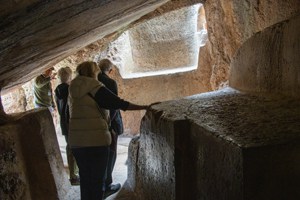
Unfortunately for both archeologists and today’s travelers, the Spanish conquerors used Sacsayhuaman as a quarry for building churches in Cusco.
About 15 minutes’ drive beyond Sacsayhuaman is Qenco. Meaning zig-zag in Quechua, this temple is named for the crooked channels cut out of its rock. The site, smaller than many others, consists of man-made tunnels and a natural cave with an altar.
An extremely holy place for the Incas, it’s thought the site was carved out of a gigantic monolith. The Incas made blood sacrifices to the gods here and the dead were embalmed in the windy tunnels.
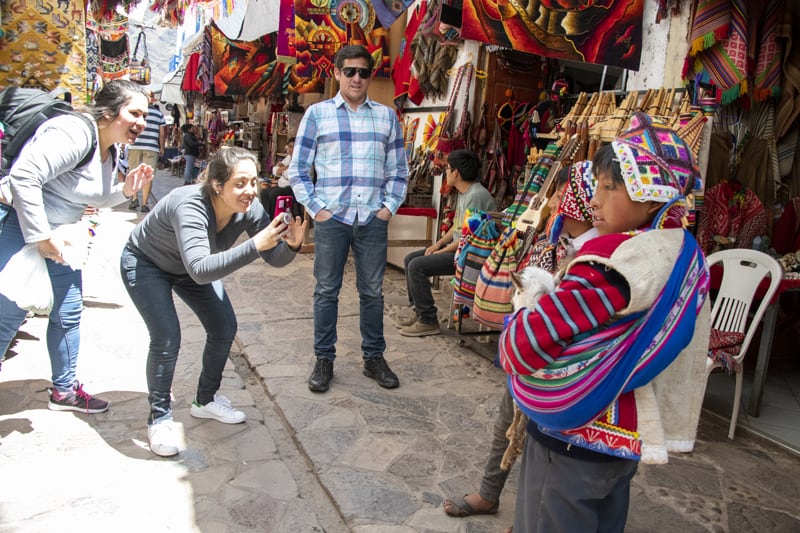
Colorful Pisac
The Spanish conquistadors strategically placed Pisac along the Urubamba River, atop an Incan settlement. The small town has now grown to encompass both sides of the river. It’s a typical Spanish Colonial town, with a central plaza and streets laid out in a grid system.
Pisac has a popular Sunday Market in the plaza (highly recommended), which is a favorite of many travelers. It’s an excellent place to buy arts and crafts, alpaca clothing, ceramics, and silver objects. It’s also a perfect place to photograph the friendly locals, many in their traditional costumes, worn daily.
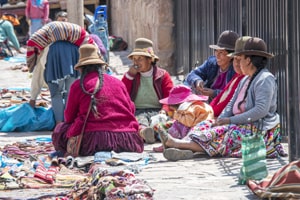
The Incas built the town to defend the Sacred Valley’s northern end, and high above Pisac are the old ruins of the ancient Inca fortress. The ruins above Pisac are the largest Incan citadel city. Agricultural terraces and dramatic mountain views of Peru’s Sacred Valley surround it.
In the citadel, stone water channels lead to what archaeologists believe was an Inca bathhouse. There is also an ancient Inca cemetery here, the largest Incan cemetery in South America. 3,000 Incas are believed to be buried in the mountain crevices.
If you’re energetic and don’t have acrophobia, you can reach it from Pisac in a few hours by walking up a steep, narrow stone staircase. The rest of us can opt for a taxi to the top (about 20–25 Peruvian soles (US$ 7 – 8.50) to do our exploring.
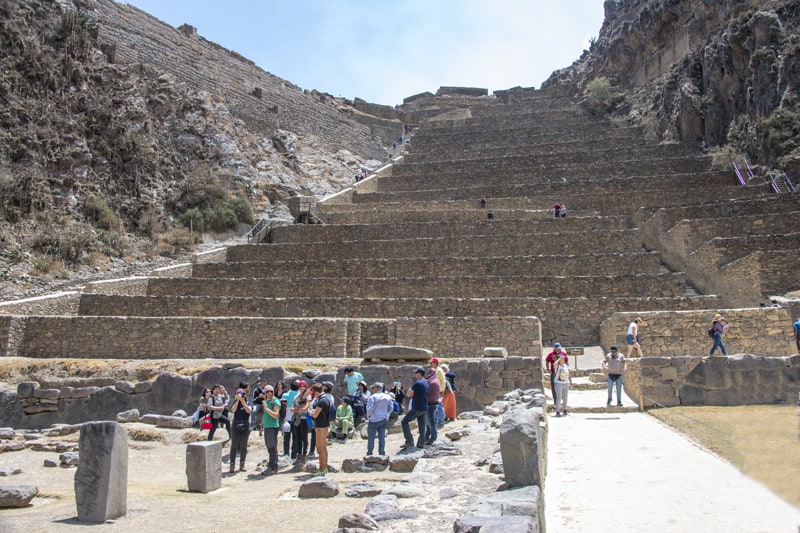
Ollantaytambo, Not Just For the Train
For many travelers, Ollantaytambo is the station to board the train to Aguas Calientes, the stop for Machu Picchu. But it’s well worth visiting Ollantaytambo for a few hours since it has the most original and best-preserved Inca and pre-Inca ruins in the Sacred Valley and all of Peru. They include a large citadel and a series of terraces on the hillside. It’s also best to have a guide here to explain everything you’ll be seeing.
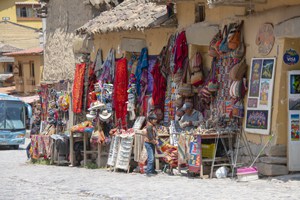
45 miles from Cusco, it was in Ollantaytambo where the Incas defeated the Conquistadors in 1536. They used their irrigation system to flood the valley floor, bogging down the Spaniards’ horses. Unfortunately, it was a short-lived Inca victory.
Nevertheless, you can see the genius of the Incas here. Visit the newer town, a Spanish colonial village built upon the Inca village, that’s interesting and picturesque.
As you’ll see while wandering about, it’s also an example of Inca urban planning. The streets, lined with large Inca-built walls, are quite impressive, although they can sometimes become clogged with buses. Some of the Inca-built buildings are in the town itself and are still in use today.
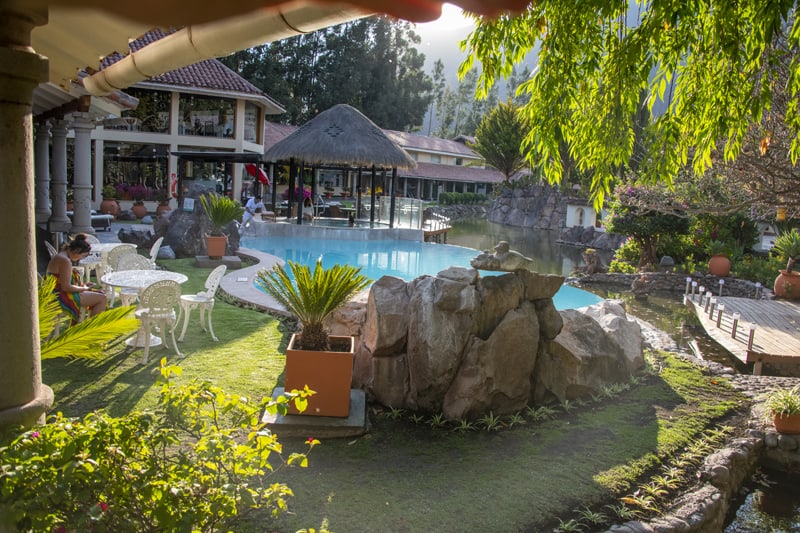
Two Great Hotels
You’ll find hotels for every budget in Cusco and the Sacred Valley in Peru, including some great hotels. We decided to splurge and chose the latter.
In the Sacred Valley, we stayed at the Aranwa Sacred Valley Hotel & Wellness in Urubamba. It was a bit over an hour from Cusco, and a 40-minute drive to the Ollantaytambo train station for the ongoing trip to Machu Picchu.
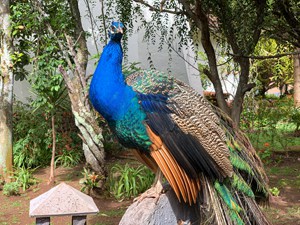
Built along a riverbank on the lands of a 17th-century colonial hacienda, it’s stunning. It has 74 modern rooms decorated in minimalist style, each with a view of the gardens, a lake, or the old hacienda. Peacocks roam the grounds and the old buildings – including a small family church – are beautiful.
The service and meals were excellent. And it certainly lived up to its advertising hype of providing “the magical encounter of two periods: the ancient Inca culture and the colonial majesty, in one of the most beautiful landscapes in the world.”
In Cusco, after our return from Machu Picchu, we stayed at the Belmond Monasterio, just a few minutes’ walk from the Cathedral. A converted monastery, it’s a unique hotel that wraps around a beautiful park-like central courtyard, its centerpiece a 300-year-old cedar tree. It’s also a protected national monument. As was the Aranwa, service, and meals were outstanding.
We found restaurants in the hotels and Cusco and the Sacred Valley to be excellent. In the past decade or two, Lima has become a foodie destination, and you’ll find much of that culinary expertise has spread to Cusco and the Peru’s Sacred Valley.
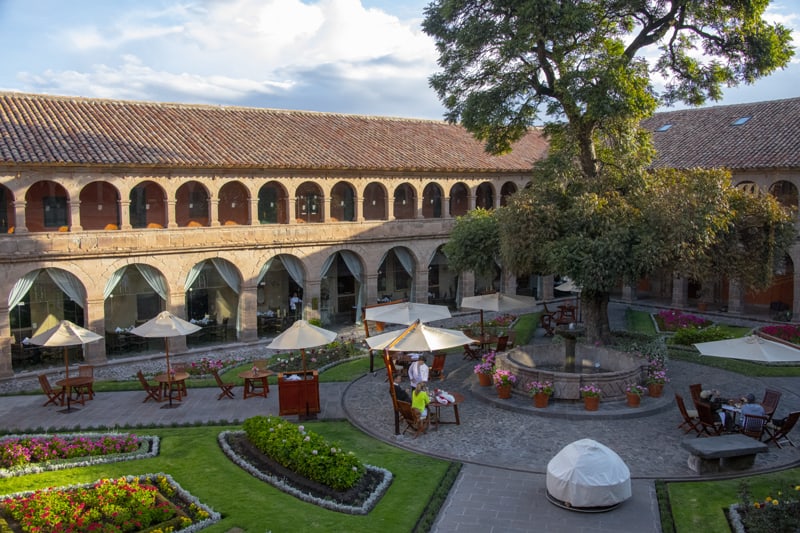
If You Go:
Aranwa Sacred Valley Hotel & Wellness
Antigua Hacienda Yaravilca, Huayllabamba
Urubamba, Cusco Perú
Tel: 084 581900
Belmond Hotel Monasterio
Calle Plazoleta Nazarenas 337
Cusco, Perú
Tel: +51 84 604 000 / 1 800 237 1236
You may also enjoy: A Luxury Amazon River Cruise in Peru / 10 Small Countries That Score Big With Travelers / A Lima Holiday: Exciting, Delicious, Affordable
Tourist Tickets for Cusco and Sacred Valley Sites in Peru
Also known as BTC, this ticket allows entry to 16 of the significant sites in Cusco and the Sacred Valley. It’s valid for 10 days and worth buying since it provides entrance to the major sites. You can also purchase “partial” tickets – valid for one or two days – for a select group of sites.
A 10-day ticket costs 130 Peruvian sol (about $35); students 70 sol (about $19). Show your passport and purchase your tickets at any of the sites you visit.
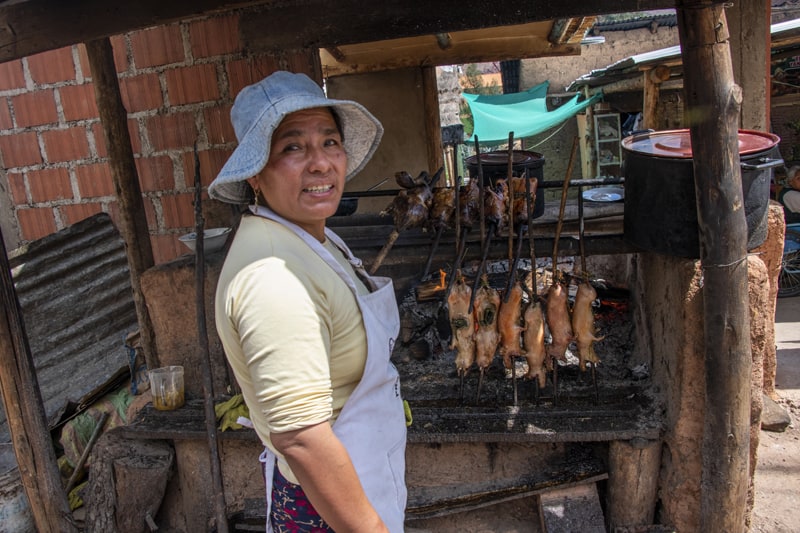
When to Travel to Peru’s Sacred Valley
The peak travel season to the Sacred Valley and Machu Picchu is from June to August. A good time to visit is in April and May, right before peak season, or after the peak in September and October, but before the rains begin.
The rainy season is December through March, a time the temperature range is 59˚–80˚ Fahrenheit (15˚– 27˚ Celsius). The dry season extends from April to November with temperatures ranging from 50˚ to 72˚ Fahrenheit (10˚– 22˚ Celsius).
We visited Peru and the Sacred Valley in late September/early October and enjoyed beautiful weather, with only an occasional short rain shower.

I am so fascinated by everything in your story! My father once took a group tour to some of these places years ago. He talked so highly of Cusco. I dream of visiting, too. You describe it all so well. Thanks!
Thank you Carla. Cusco is very interesting.
Very well written and informative article! Thank you for sharing your insights into these must-see places when visiting Machu Picchu.
Thank you Theresa!
Thank you for posting the beautiful article and images! My husband and I visited 6 years ago and were entranced with the beauty, history and delicious food. Your article brought back many happy memories, especially of Ollantaytambo.
You’re welcome Sarah. I was also astounded by it. It’s a beautiful area of the world.
My Sept. 1975 trip to Bolivia & Peru was one of the most memorable from my worldwide adventures in my travel industry career. With a mining/geology student from France I met, we took the early morning local train from Cusco, standing up the entire way to Aqua Calientes. No deluxe hotels or electricity there then. We rented bunks for 50 cents behind the general store, where petty-coated women bedded down on the floor when the sun set. I bought a candle for 5 cents & walked like Hansel & Gretel into the woods to soak in the natural “hot springs” sharing an hour with a few teens. Early morning we walked about 2 km along the rail tracks beside the Urubamba River to the base of Machu Picchu. Here we stood up in the back of the truck returning empty trash containers (the chilled air didn’t mask the pungent odor!) and other goods up the switch-backed Hiram Bingham road to the hotel at the top of the ruins. Serendipity reigns!
Richard – what a story! These are the memories that stay with one forever. I’m glad to hear all about it.
My wife and I have been to Peru twice in the last 4 years. The Sacred Valley is loaded with attractions, and Cusco is a great hub. Our last trip, we did Hamantuy Lagoon, Rainbow Mountain from Cisco, and they were worth the demanding hike in. Also did Paracas and the Hacuachina Oasis in the desert, where we dune buggied ( major adrenaline rush!) And sandnoarded down the dunes. This was 1 daytrip from Lima, and I would highly recommend it!
Hi Steve,
Thanks for your comment. I totally agree with you that the Sacred Valley is loaded with attractions. You did a few things that we hadn’t gotten to. I’s like to look into them the next time we’re in Peru.
Jim